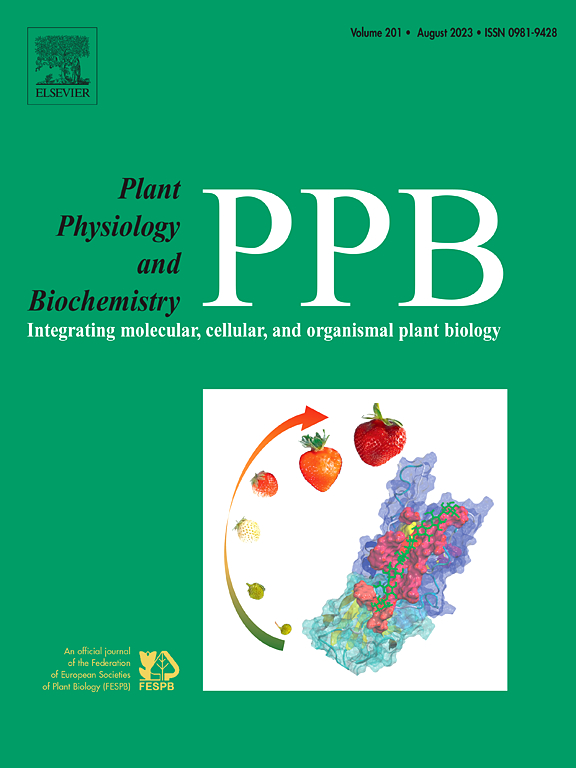High-light and nutrient interactions drive carbohydrate and proton pump dynamics in Agastache rugosa (Fisch. & C.A.Mey.) Kuntze
IF 6.1
2区 生物学
Q1 PLANT SCIENCES
引用次数: 0
Abstract
Agastache rugosa, a perennial herb native to temperate and subtropical regions, shows remarkable adaptive strategies when exposed to varying light and nutrient conditions in tropical environments. Our study reveals new insights into the crosstalk mechanisms involving carbohydrate homeostasis, biomass allocation, and nutrient acquisition in A. rugosa under different environmental conditions. Treatments were two light levels; HL (high-light, 0% shade) and LL (low-light, 50% shade), and four nutrient rates; NPK1 (40 mg kg−1), NPK2 (80 mg kg−1), NPK3 (120 mg kg−1) and NPK4 (160 mg kg−1). High-light coupled with increasing nutrient levels (HL-NPK3 and HL-NPK4) promoted biomass production via increased carbon assimilation, associated with higher soluble sugar levels and higher phosphorus and potassium uptake mediated by the upregulation of plasma membrane H+-ATPase. Maximum carbohydrate accumulation occurred at high-light and the lowest nutrient levels (HL-NPK1), coinciding with increased nitrogen uptake and the drastically high leaf nitrogen concentration. This response was preceded by the upregulation of acid phosphatase and sucrose phosphate synthase, suggesting a compensatory mechanism to maintain nutrient and carbohydrate reserves for critical metabolic processes. Starch increase was more apparent under low-light and higher nutrient levels (LL-NPK3 and LL-NPK4), relative to invertase downregulation, indicating a shift towards carbohydrate storage rather than utilization. These findings underscore the complex interplay between sugar signaling, nutrient sensing, enzymatic actions, and proton pump activity in modulating plant adaptation to varying environmental conditions. This study also highlights the importance of understanding how non-model medicinal species like A. rugosa reprogram their metabolism and resource allocation in response to environmental changes.
高光和营养相互作用驱动黑穗桃碳水化合物和质子泵动力学。& C.A.Mey)。Kuntze。
赤芍是一种原产于温带和亚热带地区的多年生草本植物,在热带环境中,赤芍在不同的光照和营养条件下表现出了显著的适应策略。本研究揭示了不同环境条件下黑穗草碳水化合物稳态、生物量分配和养分获取的串扰机制。处理为两个光照水平;HL(强光,0%遮荫)和LL(弱光,50%遮荫),四种营养水平;NPK1 (40 mg kg-1), NPK2 (80 mg kg-1), NPK3 (120 mg kg-1)和NPK4 (160 mg kg-1)。高光和营养水平的增加(HL-NPK3和HL-NPK4)通过增加碳同化促进了生物量的产生,并通过上调质膜H+- atp酶介导了更高的可溶性糖水平和更高的磷钾吸收。高光和最低营养水平(HL-NPK1)下碳水化合物积累最多,与氮吸收增加和叶片氮浓度急剧升高相一致。这种反应发生在酸性磷酸酶和蔗糖磷酸合酶上调之前,这表明存在一种代偿机制,以维持关键代谢过程的营养和碳水化合物储备。在低光照和高营养水平(LL-NPK3和LL-NPK4)下,相对于转化酶的下调,淀粉的增加更为明显,表明转化酶向碳水化合物储存而非利用转变。这些发现强调了糖信号、营养感知、酶作用和质子泵活性在调节植物适应不同环境条件中的复杂相互作用。该研究还强调了了解像rugosa这样的非模式药用物种如何根据环境变化重新编程其代谢和资源分配的重要性。
本文章由计算机程序翻译,如有差异,请以英文原文为准。
求助全文
约1分钟内获得全文
求助全文
来源期刊
CiteScore
11.10
自引率
3.10%
发文量
410
审稿时长
33 days
期刊介绍:
Plant Physiology and Biochemistry publishes original theoretical, experimental and technical contributions in the various fields of plant physiology (biochemistry, physiology, structure, genetics, plant-microbe interactions, etc.) at diverse levels of integration (molecular, subcellular, cellular, organ, whole plant, environmental). Opinions expressed in the journal are the sole responsibility of the authors and publication does not imply the editors'' agreement.
Manuscripts describing molecular-genetic and/or gene expression data that are not integrated with biochemical analysis and/or actual measurements of plant physiological processes are not suitable for PPB. Also "Omics" studies (transcriptomics, proteomics, metabolomics, etc.) reporting descriptive analysis without an element of functional validation assays, will not be considered. Similarly, applied agronomic or phytochemical studies that generate no new, fundamental insights in plant physiological and/or biochemical processes are not suitable for publication in PPB.
Plant Physiology and Biochemistry publishes several types of articles: Reviews, Papers and Short Papers. Articles for Reviews are either invited by the editor or proposed by the authors for the editor''s prior agreement. Reviews should not exceed 40 typewritten pages and Short Papers no more than approximately 8 typewritten pages. The fundamental character of Plant Physiology and Biochemistry remains that of a journal for original results.

 求助内容:
求助内容: 应助结果提醒方式:
应助结果提醒方式:


